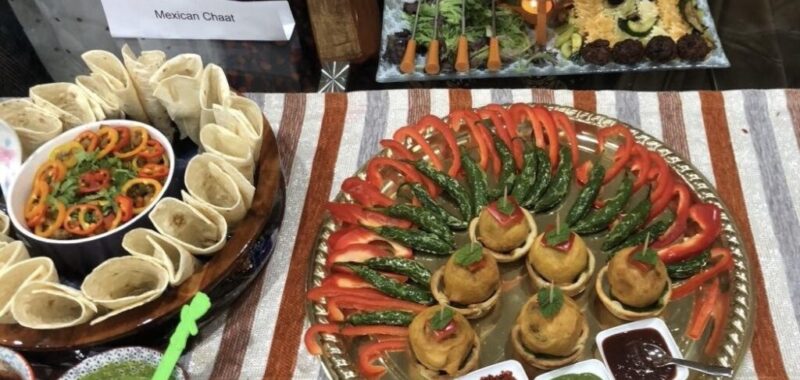
I’ve disavowed potatoes, carrots, onions, garlic, radish and beets.
Growing up as a Jain, I never ate these root vegetables or had second thoughts about my faith and this practice. At home, my mom prepared authentic Jain Gujarati meals with rotli (flatbread), daal (lentil soup), bhaat (rice) and shaak (vegetable curry). We found Jain-friendly restaurants in the Bay Area, and while traveling abroad, we microwaved meals in our hotel room and carried ready-to-eat foods.
It was always possible for me to follow my faith-based diet, until I enrolled in Cal Poly San Luis Obispo as a freshman two years ago. Suddenly, I would be forced to eat from a meal plan, cook in a communal dorm kitchen or find suitable off-campus dining options.
Little known outside of India, Jainism is an ancient religious faith whose central tenet is ahimsa, or nonviolence toward all living beings. Jains traditionally do not consume animal products such as meat, eggs and honey, nor root vegetables, in accordance with this principle to avoid harming organisms living in the soil.
Some may perceive the Jain diet to be a list of limitations. However, it is meant to be the opposite. In fact, it has empowered me to make more mindful and compassionate choices when it comes to my lifestyle and consumption.
Being so closely connected to and influenced by the Bay Area’s Jain community, my faith has now become an integral aspect of my background, culture and identity, and is the reason behind my commitment to the Jain diet throughout college.
As I prepared to leave for Cal Poly in September 2022, I was unsure of how I would be able to find Jain food as a freshman on a meal plan. I decided to contact campus dining before starting school and, to my surprise, they responded swiftly. After exchanging preliminary emails discussing my unique dietary needs, we came up with a plan.
I met with Kaitlin Gibbons, a registered dietitian for the campus dining program, and we created a specialized meal plan, rotating between four dishes each week. This included pasta, stir-fry, a veggie wrap and quesadillas. She also introduced me to the chefs and kitchen staff who prepared my food as I picked it up every day.
Cal Poly works with students who have food allergies, gluten intolerance, follow vegan or vegetarian diets or who, like me, have faith-based diets.
“I (work) one-on-one with students with dietary restrictions to assist in empowering them to self-manage their dietary choices on campus, allowing them to actively participate in the college dining experience,” Gibbons said.
To meet the diverse needs of students, Gibbons collaborates with executive chefs like Chris Dunham and culinary teams to offer inclusive meal plans.
Of course, my limited range of meals meant that, unlike my peers, I could not make spontaneous lunch or dinner plans to grab food at just any eatery. I also had a number of leftover dining dollars because I couldn’t purchase most other food/snack options. To use up my dollars, I had to frivolously buy granola bars or random candies from the campus market.
As a result, I stocked up on snacks, homemade dehydrated foods, and brought cooking ware like an Instant Pot to make quick meals in my dorm’s kitchen.
Nevertheless, I am grateful to Cal Poly’s dining team and to Kaitlin for understanding and accommodating my dietary needs; however, this is not the case for all students on other campuses.
My friend Arushi Shah is a biomedical engineering sophomore at the University of California Riverside, and she similarly follows the Jain tradition of avoiding root vegetables.
Shah said that during her first year in college, she was not on a meal plan because her college refused to accommodate her diet and offer suitable options.
“I wished they could make at least one to two dishes for me,” Shah said.
Instead, she found creative alternatives to prepare food in her dorm all year long. This included taking dehydrated meals from home, packing non-perishables and storing frozen food in her fridge.
“I actually asked my mom to make me instant food items where I just add hot water and it’s ready,” Shah said. “Other times I would go upstairs to my suite kitchen and make easy dishes that didn’t require a lot of meal prep.” Some of the meals she made included sandwiches, dosa and fried rice.
If you are in Shah’s position, she suggests “learn how to cook if a kitchen is available, and learn how to do very simple things that don’t require much time and small amounts of ingredients.”
Transitioning to college is challenging, especially while navigating dietary restrictions and advocating for your needs. To take the first step, get in touch with your school’s dining program, and relay your dietary needs to them. Preferably, you can reach out before committing to a school as accommodations may not always be guaranteed. As awareness of various faith-based dietary customs grows across colleges, we can hopefully become more inclusive in how we serve our students.
•••
Riya Parekh is a third year political science major concentrating in pre-law at Cal Poly San Luis Obispo and a member of EdSource’s California Student Journalism Corps.
The opinions in this commentary are those of the author. We welcome guest commentaries with diverse points of view. If you would like to submit a commentary, please review our guidelines and contact us.

